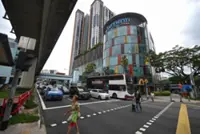Paul Lee captured lightning striking over the area close to Marina during last year’s lightning season. - PAUL LEE
SINGAPORE (The Straits TImes/Asia News Network): Whether rain or shine, there is lightning streaking across Singapore’s skies on 175 days or about half the year.
And three avid photographers who are part of an interest group called SGStormTrackers have been carrying their cameras and chasing the perfect shot of lightning bolts.
Already a subscriber? Log in
Save 30% OFF The Star Digital Access
Cancel anytime. Ad-free. Unlimited access with perks.





